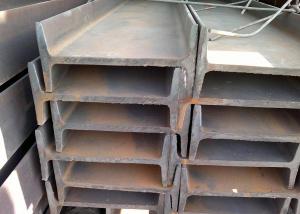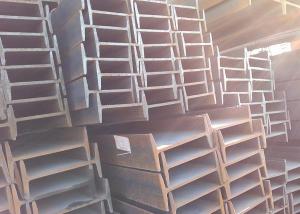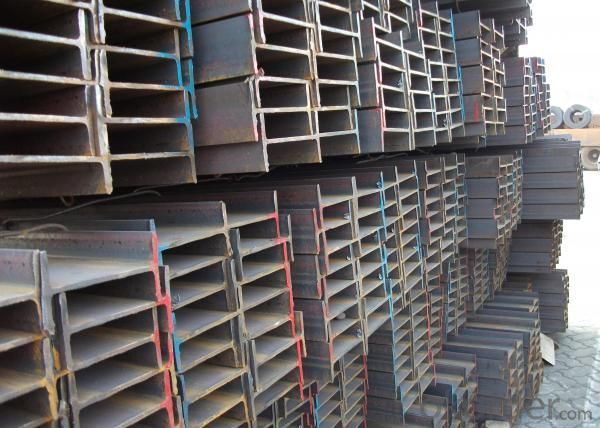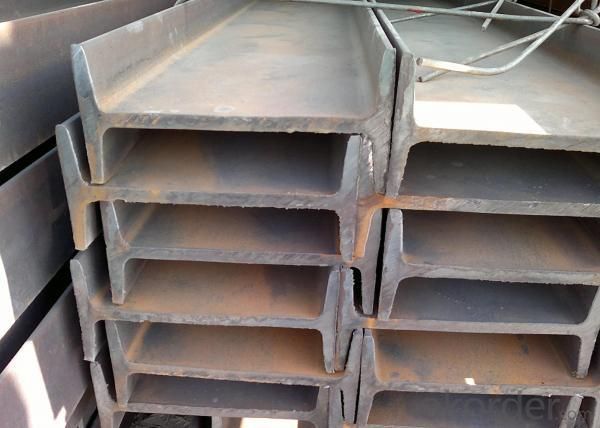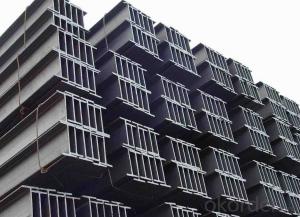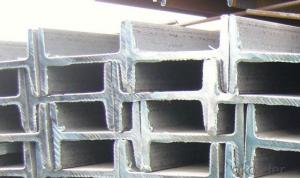IPE Beam
- Loading Port:
- Tianjin Port, China
- Payment Terms:
- TT or LC
- Min Order Qty:
- 10MT m.t.
- Supply Capability:
- 10000MT m.t./month
OKorder Service Pledge
OKorder Financial Service
You Might Also Like
Specifications of IPE Beam
1. Invoicing on theoretical weight or actual weight as customer request
2. Standard: EN10025, GB Standard, ASTM
3. Grade: Q235B, Q345B, SS400, ASTM A36, S235JR, S275JR
4. Length: 5.8M, 6M, 9M, 12M as following table
5. Sizes: 80mm-270mm
|
Dimensions(mm) | |||||
|
|
h |
b |
s |
t |
Mass Kg/m |
|
IPE80 |
80 |
46 |
3.80 |
5.20 |
6.00 |
|
IPE100 |
100 |
55 |
4.10 |
5.70 |
8.10 |
|
IPE120 |
120 |
64 |
4.80 |
6.30 |
10.40 |
|
IPE140 |
140 |
73 |
4.70 |
6.90 |
12.90 |
|
IPE160 |
160 |
82 |
5.00 |
7.40 |
15.80 |
|
IPE180 |
180 |
91 |
5.30 |
8.00 |
18.80 |
|
IPE200 |
200 |
100 |
5.60 |
8.50 |
22.40 |
|
IPE220 |
220 |
110 |
5.90 |
9.20 |
26.20 |
|
IPE240 |
240 |
120 |
6.20 |
9.80 |
30.70 |
|
IPE270 |
270 |
135 |
6.60 |
10.20 |
36.10 |
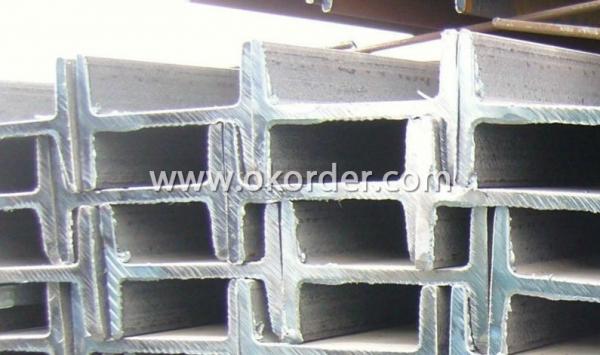
Appications of IPE Beam
1. Supporting members, most commonly in the house raising industry to strengthen timber bears under houses. Transmission line towers, etc
2. Prefabricated structure
3. Medium scale bridges
4. It is widely used in various building structures and engineering structures such as roof beams, bridges, transmission towers, hoisting machinery and transport machinery, ships, industrial furnaces, reaction tower, container frame and warehouse etc.
Package & Delivery of IPE Beam
1. Packing: it is nude packed in bundles by steel wire rod
2. Bundle weight: not more than 3.5MT for bulk vessel; less than 3 MT for container load
3. Marks: Color marking: There will be color marking on both end of the bundle for the cargo delivered by bulk vessel. That makes it easily to distinguish at the destination port.
4. Tag mark: there will be tag mark tied up on the bundles. The information usually including supplier logo and name, product name, made in China, shipping marks and other information request by the customer.
If loading by container the marking is not needed, but we will prepare it as customer request.
5. Transportation: the goods are delivered by truck from mill to loading port, the maximum quantity can be loaded is around 40MTs by each truck. If the order quantity cannot reach the full truck loaded, the transportation cost per ton will be little higher than full load.
6. Delivery of IPE Beam: 30 days after getting L/C Original at sight or T/T in advance

Production flow of IPE Beam
Material prepare (billet) —heat up—rough rolling—precision rolling—cooling—packing—storage and transportation
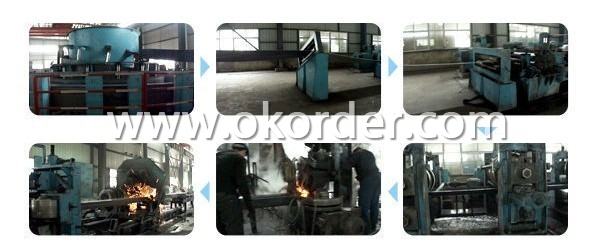
- Q:Can steel I-beams be used in overhead crane systems?
- Yes, steel I-beams can be used in overhead crane systems. They are commonly used as the main support structure for the crane and provide the necessary strength and durability to lift and transport heavy loads safely.
- Q:Can steel I-beams be used in historical preservation or restoration projects?
- Yes, steel I-beams can be used in historical preservation or restoration projects. However, it is important to ensure that their use aligns with the historical significance and aesthetic of the building or structure being preserved. In some cases, steel I-beams can be concealed or integrated in a way that maintains the architectural integrity of the historical structure.
- Q:Do Steel I-Beams require special handling during installation?
- Special handling is required for the installation of Steel I-Beams due to their heavy weight and large size. To ensure safe and efficient installation, several key considerations must be taken into account. Firstly, specialized lifting equipment such as cranes or forklifts with sufficient lifting capacity should be utilized to handle and position the I-Beams. This will prevent any damage during the lifting process and reduce the likelihood of accidents. Adequate manpower is also necessary to assist in the handling and installation of Steel I-Beams. Trained personnel should be assigned to guide and direct the lifting equipment, ensuring proper alignment and positioning during installation. Protective measures should be implemented to prevent scratches, dents, or other damage to the I-Beams during transportation and installation. This can be achieved by using protective coverings or padding to prevent contact with other surfaces or objects. Once the I-Beams are in position, it is crucial to secure them properly to prevent any potential movement or displacement. This may involve using appropriate connectors, bolts, or welding techniques as specified by the structural engineer or manufacturer. Compliance with safety regulations is essential throughout the handling and installation process. Workers should be equipped with the necessary personal protective equipment (PPE), and all relevant safety protocols should be followed. By adhering to these special handling procedures, Steel I-Beams can be safely and effectively installed, minimizing the risk of accidents, damage, or structural issues.
- Q:Do steel I-beams require any maintenance?
- Yes, steel I-beams do require maintenance. Regular inspections should be conducted to check for signs of corrosion, damage, or structural issues. Any necessary repairs or replacements should be carried out promptly to ensure the integrity and safety of the beams. Additionally, protective coatings or paint can be applied to prevent corrosion and extend the lifespan of the beams.
- Q:Is the I-beam generally made or is it a long one?
- I-beam is also called steel girder (I Beam). It is a long strip steel with cross section. I-beam is divided into ordinary I-beam and light I-beam, H steel three. I-beam is widely used in various building structures, bridges, vehicles, supports, machinery and so on.
- Q:How do steel I-beams perform in terms of thermal bridging?
- Steel I-beams are known to have high thermal conductivity, which means they can conduct heat more easily compared to other building materials. This characteristic makes them prone to thermal bridging, which is the transfer of heat across a building envelope or thermal barrier. When steel I-beams are used in construction, they can create a thermal bridge in the building envelope. This means that heat can be easily transferred from the inside to the outside or vice versa through the steel beams. Thermal bridging can result in energy loss and reduced energy efficiency in a building. To mitigate thermal bridging in steel I-beams, insulation materials can be added around the beams to minimize heat transfer. Insulation can help reduce the impact of thermal bridging and improve the overall thermal performance of the building. Additionally, thermal breaks can be installed between the steel beams and the surrounding building elements to further reduce the heat transfer. In summary, steel I-beams have a high potential for thermal bridging due to their high thermal conductivity. However, with proper insulation and the use of thermal breaks, the negative effects of thermal bridging can be minimized, resulting in improved energy efficiency and thermal performance of the building.
- Q:Are steel I-beams suitable for residential basement walls?
- Steel I-beams can be suitable for residential basement walls, depending on the specific circumstances and requirements of the project. Steel I-beams offer several advantages, such as high strength-to-weight ratio, durability, and resistance to various forces like bending, shearing, and compression. One of the main benefits of using steel I-beams in basement walls is their ability to support heavy loads, making them ideal for areas with expansive soil or high water tables. They can resist the lateral pressure exerted by the soil and prevent basement wall failure, which is a common concern in residential construction. Moreover, steel I-beams are non-combustible, providing an added level of fire protection compared to other materials like wood. This can enhance the safety of a residential basement, especially when considering potential hazards such as fire or smoke spreading from adjacent spaces. However, it is essential to consider a few factors before deciding to use steel I-beams for residential basement walls. Firstly, the cost of steel I-beams can be higher than other materials, which might impact the overall budget of the project. Secondly, the installation process may require specialized equipment and skilled labor, potentially increasing the complexity and time needed for construction. Additionally, steel I-beams may require proper insulation to prevent thermal bridging, as metal conducts heat more readily than materials like wood or concrete. Adequate insulation will help maintain a comfortable temperature in the basement and reduce energy consumption. In summary, steel I-beams can be suitable for residential basement walls, offering several advantages such as strength, durability, and fire resistance. However, it is crucial to consider factors such as cost, installation complexity, and insulation requirements before making a final decision. Consulting with a structural engineer or a professional contractor can provide valuable guidance in determining if steel I-beams are the best choice for a specific residential basement project.
- Q:Can Steel I-Beams be used for power plants?
- Indeed, steel I-beams are suitable for power plants. These beams are widely utilized in construction due to their exceptional structural strength and ability to bear heavy loads. In power plants, where the presence of heavy machinery and equipment is inevitable, steel I-beams offer the essential support and stability required. Their utility extends to numerous applications within power plants, such as providing support for turbines, generators, boilers, and other vital components. Furthermore, steel I-beams exhibit exceptional heat resistance, enabling them to endure high temperatures, which renders them highly suitable for power plants engaged in thermal energy generation.
- Q:How do steel I-beams compare to other types of structural beams?
- Considered by many to be one of the most versatile and efficient structural beams, steel I-beams possess a multitude of advantages when compared to wooden or concrete beams. First and foremost, steel I-beams boast an exceptional strength-to-weight ratio. This characteristic allows them to bear heavy loads while remaining relatively lightweight. Consequently, they are an ideal choice for large-scale construction projects, such as bridges or skyscrapers, where minimizing the weight of the structure is crucial without compromising its strength. Secondly, steel I-beams exhibit remarkable durability and structural integrity. Steel, as a highly resilient material, can withstand extreme weather conditions including earthquakes, high winds, and heavy snow loads. Moreover, it boasts an extended lifespan and requires minimal maintenance, making it a cost-effective choice in the long run. Another advantage of steel I-beams lies in their flexibility and adaptability. They can be easily fabricated and customized to meet specific design requirements. Steel can be cut, shaped, and welded into various lengths and shapes, offering greater design flexibility. Consequently, it becomes possible to create intricate structures and achieve unique architectural designs. Additionally, steel I-beams provide superior fire resistance compared to their counterparts. Being non-combustible, steel does not contribute to the spread of fire. This feature makes it a safer option for buildings and structures, particularly in areas with stringent fire safety regulations. Lastly, steel I-beams are environmentally friendly. Steel is a recyclable material, allowing it to be reused or repurposed at the end of its life cycle. By recycling steel, natural resources can be conserved, and carbon emissions associated with the production of new steel can be reduced. To conclude, steel I-beams offer numerous advantages over other types of structural beams. These advantages include a high strength-to-weight ratio, durability, flexibility, fire resistance, and environmental sustainability. Given these qualities, it is no surprise that steel I-beams have become a popular choice in the construction industry for a wide range of applications.
- Q:How do steel I-beams perform in terms of load distribution?
- The load distribution capabilities of steel I-beams are well-known. The specific design of the I-beam efficiently distributes weight and force. The strength and stiffness of the flanges, as well as the connection provided by the web, contribute to this. The design of the I-beam allows for even distribution of the load along its length, effectively transferring the weight to supporting structures like columns or walls. This capability is crucial in various construction applications, such as bridges, buildings, and industrial structures. Steel I-beams can handle heavy loads and provide structural stability due to their efficient load distribution. They can resist bending, shearing, and deflection, ensuring the safety and integrity of the structure. These load distribution characteristics make them ideal for spanning long distances and supporting significant weight. Furthermore, steel I-beams can be custom-designed and manufactured to meet specific load requirements, allowing for optimization based on the intended application. This flexibility ensures that the load distribution capabilities of steel I-beams can be tailored for different construction projects. In summary, steel I-beams are highly effective in terms of load distribution. Their unique shape and structural properties enable them to evenly distribute weight and force, making them a reliable choice for supporting heavy loads in construction projects.
1. Manufacturer Overview |
|
|---|---|
| Location | Tangshan, China |
| Year Established | 2009 |
| Annual Output Value | Above US$ 230 Million |
| Main Markets | Mid East; Southeast Asia; Korea |
| Company Certifications | ISO 9001:2008; |
2. Manufacturer Certificates |
|
|---|---|
| a) Certification Name | |
| Range | |
| Reference | |
| Validity Period | |
3. Manufacturer Capability |
|
|---|---|
| a)Trade Capacity | |
| Nearest Port | Tianjin; |
| Export Percentage | 81% - 90% |
| No.of Employees in Trade Department | 21-50 People |
| Language Spoken: | English; Chinese; |
| b)Factory Information | |
| Factory Size: | Above 500,000 square meters |
| No. of Production Lines | 1 |
| Contract Manufacturing | OEM Service Offered; |
| Product Price Range | Average |
Send your message to us
IPE Beam
- Loading Port:
- Tianjin Port, China
- Payment Terms:
- TT or LC
- Min Order Qty:
- 10MT m.t.
- Supply Capability:
- 10000MT m.t./month
OKorder Service Pledge
OKorder Financial Service
Similar products
New products
Hot products
Hot Searches
Related keywords

